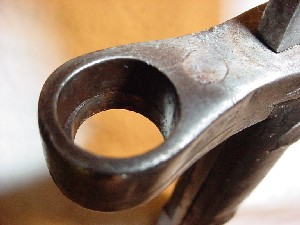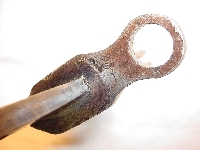
Turkish M1935 bayonet in original configuration
During the Korean War a brigade of Turkish troops participated in the UN Forces alongside US Forces and are confirmed to have acquired and used US M1 Garands and M1/M2 Carbines shortly after their initial encounters with Chinese mass attacks in 1950. The brave Turks stood their ground in the face of the initial Chinese onslaught until they were overrun. To those who survived and escaped it was painfully obvious that their issue bolt action rifles lacked the necessary firepower to deal with these Chinese wave attacks. Many of those with opportunity picked up US M1 Garands during the UN withdrawal into the Pusan perimeter and upon regrouping and re-equipping most of the rest were provided with the US weapons. Many of the other International contingents were re-armed with US Weapons as well contributing to ease of supplying them with ammunition in the field during joint operations with the predominantly US force committed under the UN banner. It remains unclear if the Turkish Brigade was formally issued US M1 bayonets at this time but none have been confirmed in Turkish use to date. What is clear is that Turkey, a prolific modifier of all sorts of bayonets, modified numerous other bayonets for use on the US M1 Garand either at this time or later for use with M1 Garand's acquired in Korea and retained by Turkey afterwards. It also remains possible that Turkey procured additional M1 Garands after the Korean War but further information regarding such potential procurement has not been found.
The most commonly found Turkish M1 bayonet conversion is based on Turkey's existing M1935 bayonet for their various and sundry "Mausers".

Turkish M1935 bayonet in original configuration
These originally conformed to an "export pattern" configuration with regard to those critical dimensions determining what rifle a given bayonet will fit on. A few other "export pattern" bayonets include Spanish M1893, Chilean M1895, Chinese Hanyang 88, Serbian M1899 and many others. All of these "export pattern" bayonets are interchangeable and Turkey's earlier bayonet models of 1890, 1903 and 1913 as well as the all steel Turkish Ersatz model of 1916 were of this same pattern and remained in service alongside the M1935 bayonet. The post 1935 issued 1890 and 1903 models usually had their longer blades shortened and often had their hooked quillions removed to more closely emulate the standard M1935 bayonet. Additional foreign models were also heavily modified to "export pattern" configuration for use on Turkey's "Mausers". Foremost among these were British P1907, Romanian M1893, German S98/05 and seemingly the entire spectrum of First World War Imperial German Ersatz bayonet models.
While not all of these models have yet been observed converted to M1 Garand bayonets it must be considered possible to find Turkish conversions of any "export pattern" bayonet in their possession to an M1 Garand fitting configuration. 2 methods of bayonet conversion for the M1 Garand are known.
The first method, used on M1935 bayonets and other non ersatz models, consists of the addition of a steel plate on the back of the crossguard with a smaller "muzzle ring" hole of 13.4mm inside diameter. The plate's extension rearwards from the back of the original crossguard compensates for part of the reduced "lug to muzzle" distance of the M1 Garand compared to "export pattern" configuration. The thickness of the plates varies considerably from bayonet to bayonet suggesting that the plates were made from "scrap" steel or just whatever steel plate material was readily available to those performing the conversion with little or no regard for any standard thickness. The plates were affixed to the original crossguard by means of a pin inserted from front to rear through both the crossguard and the conversion plate and located between the muzzle ring and the hilt. The new muzzle ring hole in the conversion plate is offset towards the bottom of the original 15.5mm "export pattern" muzzle ring to compensate for the M1 Garand's reduced barrel diameter of 13.4mm fitting only over the exposed tip of the M1 barrel. It does not seat down over the gas collar extension/muzzle ring bushing which the M1 Garand employed to fill up the larger muzzle ring of the M1905 "Springfield" bayonet which it was originally designed to accept. This leaves the new muzzle ring situated farther forward than that of the US M1905 and US M1 bayonets and compensates for the balance of the different lug to muzzle distance from the "export pattern" configuration. The backstrap surface of the pommel along the mortise slot is lightly "shaved" to allow it to better fit the M1 Garand's bayonet lug which does not extend quite as far from its base as "export pattern" bayonet lugs.

Turkish M1935 bayonet converted to M1 garand configuration
mounted on the M1 garand.

Closeup of the M1 conversion from the front of the
crossguard. Note the retaining pin between muzzle ring and spine
of blade and the visible offset of the smaller conversion plate muzzle
ring visible through the original export pattern ring.

COURTESY SARO-GARCIA
COLLECTION
Romanian M1893 bayonet which was previously converted by Turkey to "Export Pattern" configuration and subsequently converted to M1 Garand configuration in the same fashion as the M1935 Standard Model conversions for the US M1 Garand.
The second conversion method, used on all steel ersatz bayonets, consisted of having the crossguard completely replaced with one designed specifically to fit the exposed muzzle tip of the M1 Garand. This crossguard is very similar to the commonly seen stamped crossguard installed on former Imperial German ersatz bayonets to convert them to export pattern configuration but has a smaller 13.4mm muzzle ring and is noticeably flattened on the sides with a pointed "quillion" end.
I believe that this flattening was for the purpose of quickly differentiating M1 Garand conversion ersatz bayonets from export pattern conversions. All examples observed to date have been for the M1 Garand only and none have been found that will mount on the Y:1903MS. It still remains possible that such conversions were also done for the Greek rifles.

COURTESY SARGO-GARCIA
COLLECTION
Turkish converted
German Ersatz bayonet mounted on US M1 Garand
A common Turkish export pattern conversion crossguard
for German Ersatz bayonets

Crossguard for M1 Garand conversions. Note the
shape is distinctly different from the export pattern crossguard which
may have been intended to give a visual method of quick differentiation
between the two types.
A scant few of these have been found with flattened sides conforming to an export pattern configuration but all of those observed have shown evidence of having had their 13.4mm muzzle rings split at the top and expanded to 15.5mm then welded closed again in an obvious additional conversion of an M1 Garand Ersatz bayonet to "export pattern".
Turkish M1 Garand conversion crossguard subsequently
converted again to export pattern configuration.
My research on all Turkish bayonets is ongoing and comments from the membership are more than welcome. I can be reached through my web page at www.eBAYONET.com where current contact information is always available. Due to a lack of access to any true source records on Turkish bayonets it has been necessary to base my research in observations of physical examples for the most part. To date I have cataloged over 300 variants with the help of other collectors using the internet to exchange information. Such help from the SABC membership will serve to expand our knowledge of these oft ignored bayonets even further. Although not offered as a specific credit here I must mention that it was fellow member Ned Heidenreich who initially identified the Ersatz to M1 conversions when the first few I found had me stumped. This article was adapted from a previous edition of my eBook- "Observations On Turkish Bayonets" when I had these conversions grouped together. The current edition is available at www.eBAYONET.com. BCN and SABC members please be sure to identify yourself to receive your member's discount off the DELIVERED retail price of $18 in the US and Canada and $22 elsewhere in the world.
OTHER REFERENCES NOTED:
[1] Saro-Garcia Collection
[2] Le Nouvel Atlas de la Baionnette de Collection, Tome 1, #383 by Jean-Pierre Vial
I am proud to announce that this article will be published in an upcoming issue of The Journal of the Society of American Bayonet Collectors.